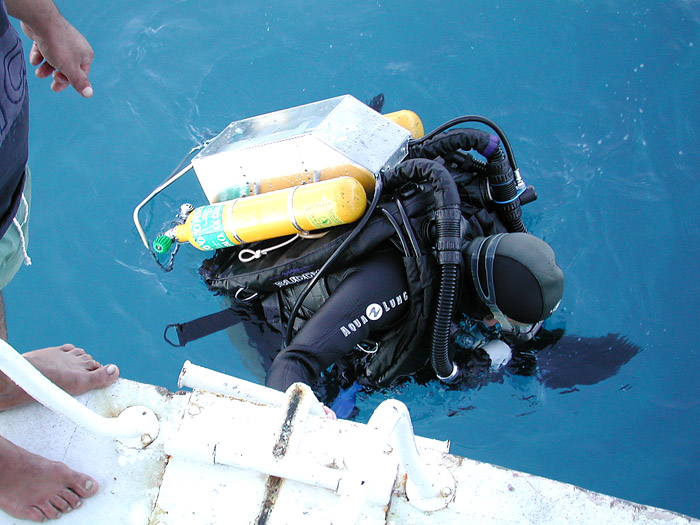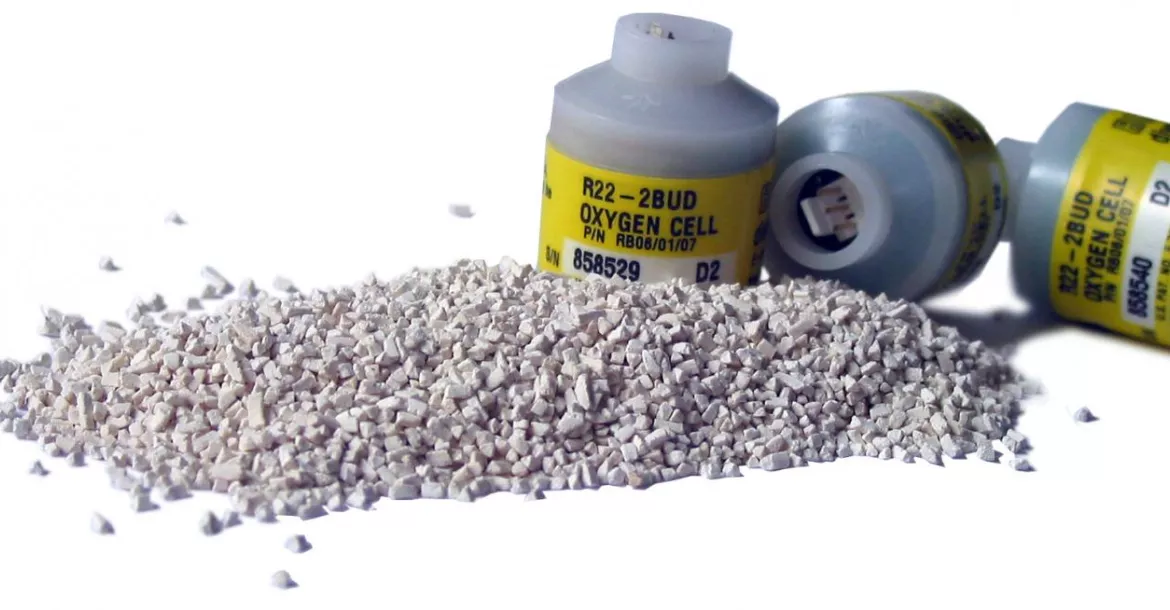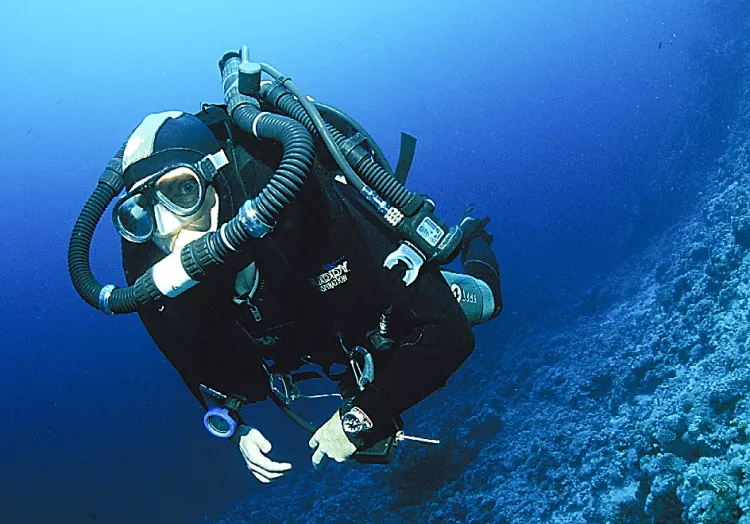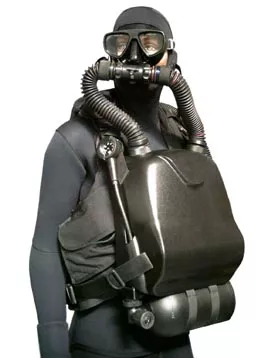There is more and more talk of rebreathers, stated as being the future of diving. However, not many people have tried them. So what is all the fuss about?
Factfile

Diving with a fully closed system is, in many ways, significantly different from diving with an open system. Several things have to be re-learned, and re-learning is much more difficult if one has long been used to diving with an open system. Many experienced divers think that they are quite competent at diving and often find it difficult to accept that they are beginners again when diving with a completely closed breathing system.
For example, they may not realise that the oxygen partial pressure can vary considerably. Also, there is a risk that a very experienced diver will make serious elementary mistakes, due to a false feeling of safety. This can lead to a failure to carry out the vital control checks of the equipment before and after each dive.
Oxygen sensors degrade (oxidise) and must be changed every year, or more often, according to how much the system has been used. The reliability of the sensors and their output is also a matter of some controversy. It happens that technical divers use fully closed systems at depths of more than 100 meters, in spite of the fact that neither the equipment nor the sensors are approved for these depths because of the doubts regarding the reduced reliability of their performance. (see, for example, the story about David Shaws fatal dive to 271m in X-RAY #3)
But, today, it is technically possible to dive to a depth of 100 meters with a couple of 3-litre tanks containing 200 bars of compressed oxygen. However, the technique is so advanced that the necessary knowledge, training and maintenance of this equipment is not yet fully integrated into the training courses offered today.
To dive safely with fully closed systems requires a thorough theoretical and practical knowledge plus frequent use in order to maintain the routines and reflexes learned during training.
The greatest majority of the readers of this magazine will have learned to dive with a regulator originating from the Aqualung, which the renowned Jacques Cousteau and Emile Gagnan invented in 1940. The regulator was the first commercial, generally available dive-system, and this promoted the later great expansion of sports diving everywhere. A
nd it must be said that the regulator is a fine piece of equipment. It is reliable, more or less foolproof, and its simple construction is very robust. These are good properties to have when one’s underwater breathing depends on them. However, as we will see, there are also a number of disadvantages. And it is these that make re-breathers an interesting alternative system.
When diving with a regulator, it is said that one is diving with an open circuit, because the exhaled air passes straight out into the surrounding water, and is thereby lost. As only about a quarter of the available oxygen has been taken up by the body, and the rest expelled, it is a rather ineffective utilisation of a scanty resource. (See table next page.)
In addition, as the amount of air used increases proportionally with depth, open systems become more and more inefficient, and there are therefore major limitations to how long a diver can remain underwater. It seems obvious, then, to try to re-use the air that has been exhaled, by using a closed system.
Closed-circuit systems
Closed-circuit systems are far from a new idea. It was Giovanni Borelli in the 1700s who first thought of re-using the exhaled air. His idea was to recirculate the air through a copper tube which was cooled by the seawater, and thereby “cleaned” the air before re-use. Luckily, it was never made. The mining industry and its problems with gas in the mine shafts also stimulated the relevant technical developments during the 1700s. Henry Fleuss, an English naval officer from Germany, worked out the principles for a re-breathing apparatus and produced a prototype at the end of the 1870s. He stayed down in a water tank for nearly an hour and later went down to 5 meters in a lake using his system.
Fleuss was the first “diver” in history with a re-breathing apparatus. At the beginning of the 1900s the military were quick to take up this idea. Oxygen-rebreathing equipment consisted of an oxygen tank together with a bag of potassium hydroxide and a breathing loop and was used to rescue submarine crews and attack divers (there were no revealing bubbles on the surface). The German manufacturer Dräger released several models for military use in connection with World Wars I and II.
Respiration
In a modern medical textbook on physiology, one of the several chapters on aspects of respiration is entitled “Physical principles of gaseous exchange; diffusion of oxygen and carbon dioxide through the respiratory membrane”. And it is these very important principles that are of great interest to divers. How we take in and utilise oxygen, and how we get rid of the carbon dioxide produced by metabolism.
Cellular metabolism is independent of pressure
The amount of air which is needed to take a normal breath at a depth of 20 meters is three times greater than at the surface, and therefore the consumption of air with open systems increases with depth. However, more importantly, cellular metabolism does not depend on pressure.
Oxygen is required to make adenosine triphosphate, ATP, the fuel of the human cell. And a molecule of oxygen is a molecule of oxygen, wherever it is to be found, at the beach, or 100 meters deep, with the corresponding increase in pressure.
Therefore, when using a closed-circuit there is the same consumption of air, whatever the depth. At rest, 0.3 to 0.5 litres of oxygen are used per minute (l/min), and with maximum work, up to 3.0 l/min are used. Of course, there are differences between individuals, depending on the size of the diver and his or her physical condition.
The carbon dioxide problem
As we have seen, cellular metabolism depends on oxygen, which is inhaled from the atmosphere. The following table gives the composition, in volume per cent, of inhaled atmospheric air (on an average cool, clear day), and also the corresponding composition of exhaled air. (There is also a minor content of the non-reactive noble gases such as argon, helium, etc., but this has been ignored here.)
It will be seen that the uptake of oxygen in the lungs has caused the oxygen content of the inhaled air to be reduced from its original 20.84% to 15.7% in the exhaled air. It will also be seen that the concentration of carbon dioxide, a by-product of metabolism, has gone up by about ninety times, to 3.6%.
So, it is not so much the reduction in the amount of oxygen that is the problem, for there is still some 16% available in each expelled breath, which should be available for re-use. It is the increase in carbon dioxide, CO2, that is the real problem. A diver can tolerate a build-up to a CO2 concentration of about 10%, increasing respiratory volume to compensate for the increased CO2.
However, beyond the 10% level the respiratory centre in the brain stem begins to be depressed rather than stimulated, and the diver’s respiration then actually begins to fall rather than to compensate. As a result of this, varying degrees of lethargy, narcosis, and, finally, anaesthesia will occur.
The CO2 in the exhaled air must therefore be removed before the remaining oxygen can be re-used. Luckily, this is quite easy to do, using calcium hydroxide, Ca(OH)2, which reacts with, and therefore fixes, the carbon dioxide. It is called CO2-scrubbing and the filtering material, in this case, the calcium hydroxide, which comes as a granulate, is referred to as the scrubber.
In a rebreather, CO2-scrubbing, therefore, takes place by circulating the breathing gas through a canister with the scrubber granulate in it.
Scrubbers
Although easy to do in principle, getting a CO2-scrubber to function in a safe and reliable way is not completely without its complications - which many divers have found out to their cost. As with walking or running, it takes work to breathe underwater. If the resistance to breathing is too high, there will be physiological problems which will limit the use of this system.
Also, hypercapnia, the condition where there is too much CO2 in the body can become an issue. The material used to remove the carbon dioxide in the system, the scrubber, has a limited life, and can only fix a certain maximum amount of carbon dioxide.
As these filters cost money, people are disinclined to change them often enough. The maximum limit for how long these filters should be used is thus some times transgressed, which increases the risk of accidents.
The matter with oxygen
And while we are at it, why not increase the oxygen level in the ínhaled air, even perhaps right up to 100% pure oxygen? This way we could also avoid breathing in nitrogen, which is the cause behind depth narcosis and decompression illness and give away with all concerns about decompression limits. If it only was so easy! The apparently paradoxical answer is that pure oxygen quickly becomes poisonous under pressure.
Partial pressure of oxygen
Assume that we have a mixture of gases. Then the total pressure of the mixture is equal to the sum of the pressures exerted separately by each of the individual components in the mixture. So, if the mixture we are considering is atmospheric air, we have:
Patmos = PN + PO + PCO2
Where
Patmos is the atmospheric pressure
PN is the partial pressure of nitrogen
PCO2 is the partial pressure of carbon dioxide
PO is the partial pressure of oxygen
Now, according to the ideal gas laws, as the components are all at the same temperature, the partial pressures must be proportional to the volumes of each gas present in the mixture. In the table given above, oxygen has a volume % of approximately 21 of atmospheric air. This means that its partial pressure is 0.21 of an atmosphere or 0.21 bar. This is oxygen’s contribution to the total atmospheric pressure.
So, at the beach, oxygen in the air has a partial pressure of ca 0.21 bar. And if the diver is using compressed air at a depth of 10 meters, then the corresponding oxygen partial pressure is 0.42 bar (0.21 x 2 bar), at 20 meters it is 0.63 bar, at 30m its 0,84 and so forth. In the literature, the partial pressure of oxygen is written as ppO2.
The importance of pp02
When discussing respiration this is probably the most important parameter to be considered. Not only must the excess carbon dioxide be removed from the air, but the partial pressure of the oxygen must also be maintained at a reasonably constant level to ensure correct cellular metabolism.
Gaseous diffusion from the alveoli of the lungs to the pulmonary blood is determined by the partial pressure of the oxygen. The partial pressure determines the force exerted in diffusion through the pulmonary membrane.
In other and more plain words, it is the ppO2 and not the O2 % that determines whether we live or die.
Consequently, ppO2 should be maintained within a certain range to sustain life. Normal ppO2 (at sea level) is, obviously, 0.21 as air contains 21% oxygen. If the partial pressure falls below 0.12 (12% oxygen at sealevel) most individuals will lose their ability to function. Below 0.10 bar ppO2 they will lose consciousness and below that die from asphyxiation.
On the other hand, a prologued exposure to high ppO2 leads to oxygen toxicity and the condition hyperoxia which manifests itself in sudden convulsions, which underwater inevitably will lead to drowning. Therefore a ppO2 of 1.6bar is usually considered the upper limit in recreational diving, and only for a limited time. And 1.3 bar the level not to exceed in general.
For these reasons, it should be clear that maintaining the ppO2 of the breathing gas within specific bounds is of utmost importance. It becomes, quite literally, a matter of life and death.
Diving conventionally with compressed air on open systems, as most regular holidaymakers do, controlling ppO2 is usually not an issue as normal air only reaches a ppO2 of 1.3 bar at a depth of 54m - far beyond where they should venture.
But as soon as we start tinkering and raising the O2-content of our breathing gas, these matters change, as we are taught already at entry-level Nitrox courses —such as PADI’s Enriched Air Specialty, or the various Basic Nitrox courses offered elsewhere.
Whether we dive on open systems or semi-closed rebreathers (see explanation below) we chose, prior to the dive, our breathing gas with a predetermined oxygen-content. This may be air or we may op for another specific gas suitable for the depths we are aiming at. In most cases this will be Nitrox–which is now becoming quite a household word among divers.
Nitrox with 32 or 36% oxygen is now quite routinely being offered at dive centres, resorts and liveaboards worldwide as these two “standard-blends” will cover most needs in the typical recreational range with near optimum benefits.
However, choosing the right oxygen-% will always be a compromise between longer no-decompression times versus maximum depth. For example, diving on Nitrox with 36% oxygen gives a generous no-deco time of 50 mins at 26m - rather than the usual 20 min when diving on air. That is nice, but Nitrox 36 can´t take you any deeper, as pp02 is already 1.3 bar around that depth.
And if you dive any shallower you don´t get the full benefits of Nitrox at that particular oxygen content. So, for each depth there seem to be an optimum oxygen % in the breathing gas. With the current general limits, this optimum oxygen content corresponds to a constant oxygen partial pressure of 1.3 bar oxygen regardless of depth.
Controlling the pp02
To ensure that the correct oxygen level is obtained, i.e. its partial pressure, it is necessary to measure its concentration. For this purpose, a special transducer is needed as an oxygen sensor. (see box below)
Modern closed breathing systems
With the advent of oxygen sensors and microprocessors, it is now possible to reduce the amount of gas taken down by a diver to a mere bagful of atmospheric air and a few litres of compressed oxygen. These closed-circuit rebreathers, CCR, use oxygen sensors to control the partial pressure of oxygen in the inhaled gas. This means that the diver can continually control and maintain oxygen partial pressure at certain levels during a dive. And this is where the fully closed rebreathers excel.
Say, for example, that a fully closed breathing system has been set to maintain a given oxygen partial pressure at depth, typically 1.3 bar. If the diver then descends to another depth, the ambient pressure increases, and with it the oxygen partial pressure in the breathing loop. The rebreather then compensates to keep the oxygen partial pressure constant.
Likewise, if the diver ascends, the pressure decreases, and the oxygen partial pressure will decrease. The apparatus will then compensate in a controlled way by injecting some more oxygen into the loop.
As the graphs above clearly demonstrate, the potential extension of no-deco times is huge.
Taking it further
Nitrogen is the usual diluent for oxygen in our normal atmosphere. However, as all divers know, nitrogen dissolves in the blood under high pressure and can cause narcosis or decompression sickness. To reduce or eliminate this problem divers would like to use as little nitrogen as possible in the inhaled air.
Remove the biologically inactive nitrogen from the inhaled air and the risk of being hit by the rapture of the deep disappears. And rebreathers can solve this problem, too, with the non-narcotic gas helium replacing nitrogen in the inhaled air being used at greater depths.
In CCRs like the Inspiration there are two tanks (see picture on previous page). One contains the oxygen which is being injected into to breathing loop to maintain the correct pp02.
The other tank contains the diluent gas, which usually is just air, but it can be anything breathable such as trimix.
This gas is, basically, the ‘base substance” of what you breathe and what the oxygen gets injected into, it is what inflates the breathing loop and what is used for buoyancy in the wing or drysuit. So with an octopus attached this tank also can double as a normal open circuit and as a backup system should there be a problem with the rebreather. (Switching to open system by closing the rebreather’s mouthpiece and breathing from the octopus instead is referred to as bail-out).
The diluent gas is normally not consumed except for what is used to inflate the breathing loop and maybe the suit and wing (some carry separate tanks for this, i.e. when argon is used for suit inflation).
For trimix divers this is very good news as Helium is a very expensive gas so using a rebreather also come a significant economic incentive.
Also it means a significant reduction in weight and the number of tanks a diver who need to explore some extreme environments like deep wrecks and caves need to carry and for this reason, the rebreather has become a preferred tool among many underwater explorers and scientists alike.
Next issue:
Diving the thing - what is it like and what the difference in skills?
Published in
-
X-Ray Mag #4
- Read more about X-Ray Mag #4
- Log in to post comments



































